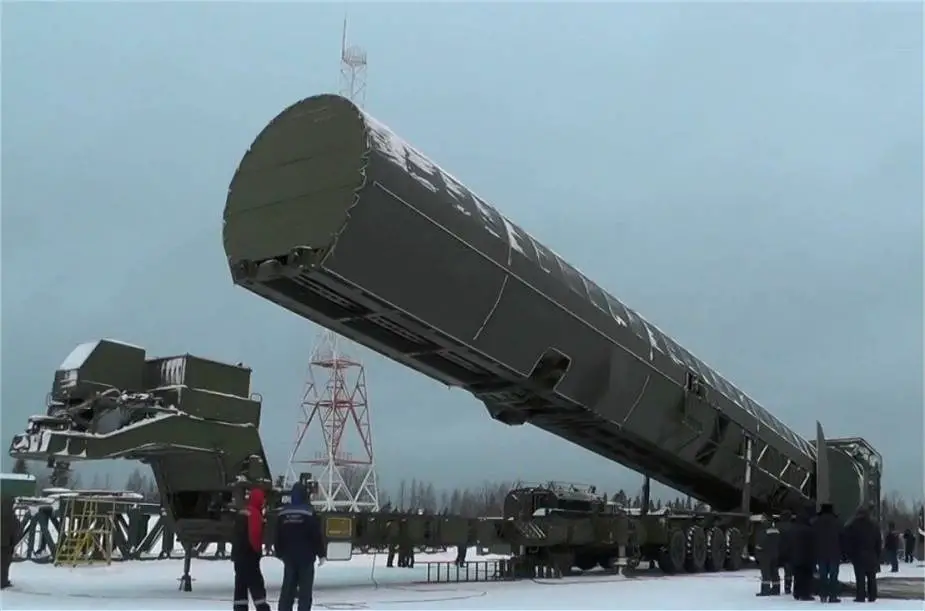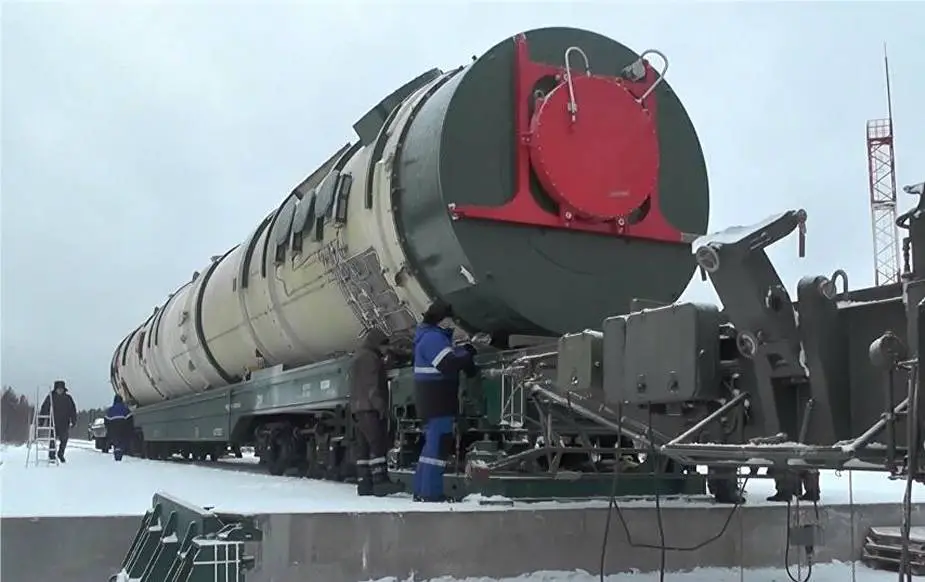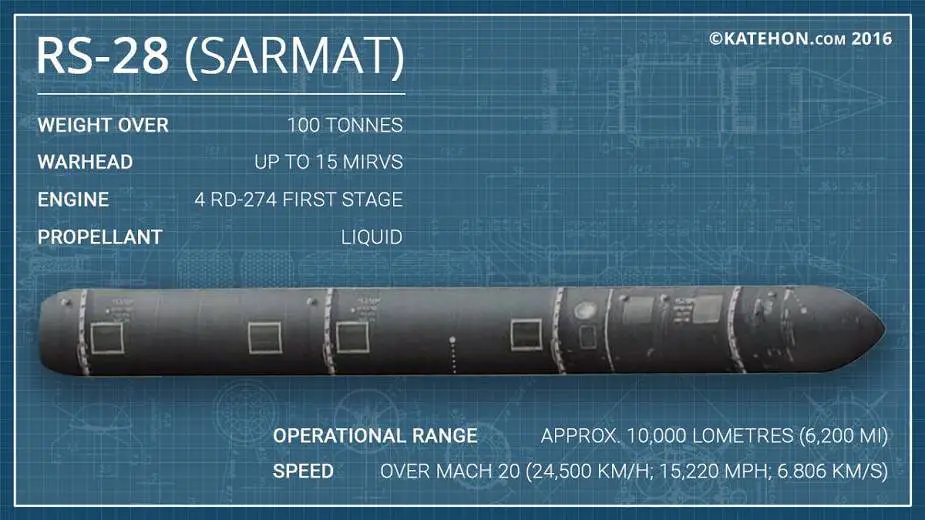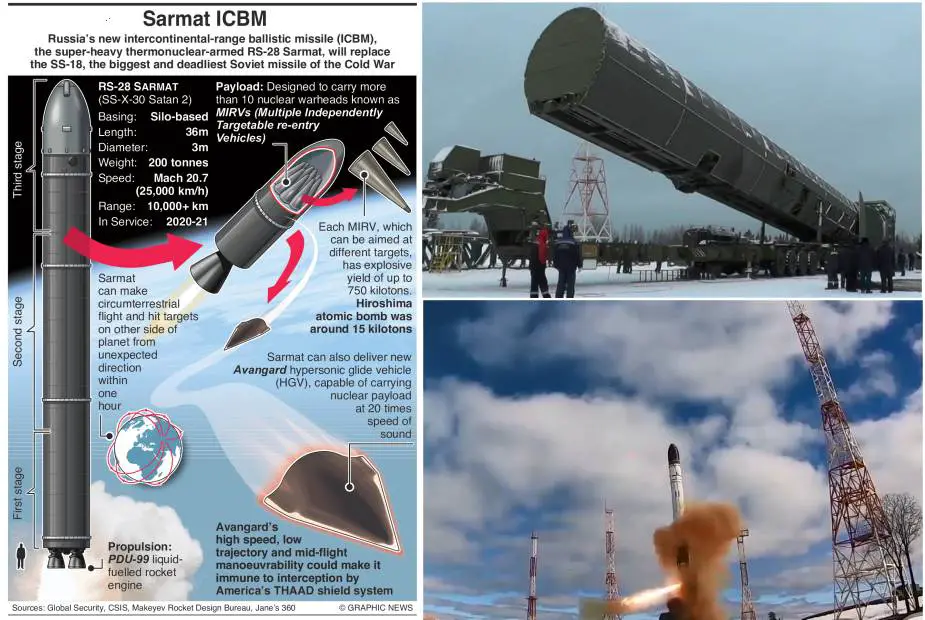- Army
- Air Defense Systems
- Anti-tank systems and vehicles
- Armored Vehicles
- Armoured personnel carriers
- Artillery Vehicles and Weapons
- Command Post
- Communication Vehicles and Systems
- Electronic Warfare
- Engineer | Maintenance Vehicles
- Infantry Fighting Vehicles
- Main Battle Tanks
- Missiles
- Tactical and Logistic Vehicles
- Radars
- Unmanned Systems
- Weapons
- Navy
- Air
RS-28 Sarmat Satan 2 II SS-X-30 ICBM
RS-28 Sarmat Satan 2 II SS-X-30 ICBM
Silo-based InterContinental Ballistic Missile - Russia

Description
The RS-28 Sarmat also nicknamed Satan 2, NATO code-named SS-X-30, is the latest generation of silo-based ICBM (InterContinental Ballistic Missile) designed by the Russian Makeev State Missile Center and produced by Krasnoyarsk Machine-Building Plant. It will replace Voevoda RS-20V (R-36M2) Satan ICBM which is in service since 1988. The development of the Sarmat started in 2009 and was unveiled by Russian President Vladimir Putin in March 2018. It was unveiled for the first time to the public in August 2019 during the Military Technical Forum defense exhibition that was held near Moscow. The first flight test was conducted in February 2020. In February 2021, the production of the ICBM was launched. On April 20, 2022, Russia conducted the first launch of a Sarmat intercontinental ballistic missile (ICBM) from the Plesetsk spaceport in the Arkhangelsk Region in north Russia. At the same time, Russia announced that 46 Sarmat ICBMs would be built. In August 2022, Russia’s Defense Ministry signed a contract for the delivery of advanced Sarmat intercontinental ballistic missiles (ICBMs) during the Army 2022 international military-technical forum. On December 21, 2022, the Russian Ministry of Defense and Russian President Vladimir Putin announced the operational deployment of the RS-28 Sarmat ICBM with the Russian Strategic Missile Forces. Citing information from a Russian military source, the United States will be unable in the coming 40 years to create an antiballistic missile defense capable of effectively intercepting Russian cutting-edge Sarmat ICBM. On September 1, 2023, Yuri Borisov, the head of Russian state space corporation Roscosmos announced that the RS-28 Sarmat intercontinental ballistic missile system has been put on combat duty.
RS-28 Sarmat Satan 2 SS-X-30 variants:
- No variants at this time.
Technical Data
| Launcher System |
|
The RS-28 Sarmat Satan 2 uses the same silo launcher units that fire Voevoda R-36M ICBM (Intercontinental Ballistic Missile). The silos are properly protected and can sustain a nuclear explosion. The missile is carried by rail from the producer enterprise to the military unit or the missile container can be transported on a four axles trailer towed by an 8x8 heavy truck. The transloading mechanisms were designed and fully tested to deliver the missile to the launch pad. The Sarmat missile is launched by the so-called mortar method. A gunpowder booster pops it up from the silo and the heavy missile hangs over the ground at a height of 20 meters for a moment. The ICBM hangs over the silo until the first engine starts up and then goes into the flight trajectory.
|
 |
| The missile is carried by rail from the producer enterprise to the military unit |
| Missile |
|
The RS-28 Sarmat Satan 2 has a range of 18,000 km, a launch weight of 208.1 tons, and a circular probable error of 500 meters. The ICBM is 35.5 meters long with a 3-meter diameter. The missile is mostly made of aluminum-magnesium alloys allowing it to be more durable, light, and provide a big payload. Composite materials are also used in the cowl and transportation-launch container, as well as other units, to decrease the radar signature of the missile. The missile carries several reentry vehicles of small, medium, and high firepower. It also has numerous dummy targets for an adversary missile shield. The payload weighs over 10 tons which can include 10 to 15 warheads, 16 smaller ones, a combination of warheads and countermeasures, or hypersonic Avangard boost-glide vehicles. The ICBM can reportedly carry three gliding hypersonic Avangard reentry vehicles. The hypersonic glide vehicle differs from traditional ballistic missiles by its ability to maneuver and operate at lower altitudes. The combination of maneuverability and high speed poses significant challenges for conventional missile defense.
|
 |
| Engine |
| The RS-28 Sarmat Satan 2 is a three-stage liquid-fueled heavy ICBM carrying 178 tons of fuel. The missile consumes a lot of fuel at the start, the stages then separate until the payload remains and flies due to the accumulated energy. The third Sarmat stage has four engines that develop a thrust of over 100 tons. The second stage has a so-called propellant or the main engine that accelerates the missile in the active stage of the trajectory. The second stage also has a four-chamber smaller engine to control the flight. It makes Sarmat fly by a flat trajectory. The missile is powered by the new RS-99 engines which are a deep upgrade of the RD-263 power plant. The increased thrust of the RS-99 engine decreases the time of the active stage of the flight and thus complicates the operation of hostile missile defense. It used a new fuel mixture that was specially developed for Sarmat. Bigger engine thrust increases the range. The active flight section has been decreased. Sarmat remains in a safe area during the boost to the trajectory. It is therefore invulnerable to adversary missile defense which targets an ICBM during the boost when it is most visible and vulnerable. During the first launch on April 20, 2022, it took the missile 20 minutes to fly six thousand kilometers and hit the target at the Kura range in Kamchatka. |
| Combat use |
| The RS-28 Sarmat Satan 2 can reportedly deliver multiple targetable re-entry vehicles worldwide. The missile can travel in any territory and can fly from the North to the South Pole. Sarmat is designed to elude anti-missile defense systems with a short initial boost phase, giving enemy surveillance systems a tiny window to track. It carries a broad range of high-power nuclear charges and is equipped with the "Mozyr" active protection system, designed to negate a potential adversary's first strike advantage by discharging a cloud of metal arrows or balls kinetically destroying incoming bombs, cruise missiles, and ICBM warheads at altitudes of up to 6 km. The RS-99 power plant accelerates Sarmat to a speed that is slightly slower than required for the orbiting of the throw weight. It approaches the target by a trajectory that reduces to zero the Pentagon's efforts to protect the USA against a nuclear attack. Only a missile defense along the perimeter of ground and sea US borders can stop Sarmat, but it is absolutely unreal financially. |
Specifications
| Type | Missile range |
| Silo-based ICBM InterContinental Ballistic Missile | 18,000 km |
| Country users | Payload Weight |
| Russia | 10,000 kg |
| Designer Country | Missile Speed |
| Russia | Over Mach 20 |
| Guidance | Missile Launch Weight |
| Inertial guidance, GLONASS, Astro-inertial | 208,100 kg |
| Warheads | Dimensions |
| Nuclear, MIRV or glide vehicles | Length: 35.3 m; Diameter: 3.0 m |
Details View
 |
Pictures - Video


























